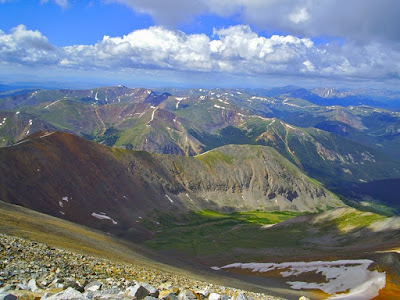Elevation: 9,100 ft - 9,300 ft
Elevation Gain: 200 ft (net), 350 ft (estimated) (cumulative)
Date Hiked: 22 June, 2011
Dogs: Unofficially off leash
Bathroom at trailhead: No
The Dillion Nature Preserve/Peninsula is a rarely visited (by non-locals) spot for running, dog walking, and mid-day hiking. It is a pleasing area with several pleasant overlooks with views of the Tenmile and Gore Ranges.
 Looking at the social trail that bypasses the road. It cuts across the bike path and then heads sharply uphill.
Looking at the social trail that bypasses the road. It cuts across the bike path and then heads sharply uphill.The calf burner social trail dumps into a small Sagebrush meadow with houses on the far side. Cross this meadow on the trail until it comes to a T. Take the right fork and you soon pass through an open fence and down into a wide gulch that looks down onto the lake. Take this trail until it starts to descend the gulch. It will be transparent, but a short way down this social trail merges into the Meadow Trail of the Nature Preserve. At 0.52 miles is the large brown sign for the Ridge and Meadow Trails. The Meadow Trail is back the way you came, while the Ridge Trail is to the left. Turn here and head up the left side to the top of the ridge that borders the gulch.
The Ridge Trail winds through a Lodgepole forest, many of which were still alive at the time of this writing. At 0.78 miles is another junction with the Meadow Trail, which loops off to the left. Continue on the Ridge Trail. At 0.90 miles is the turn off to the first overlook.
This overlook has several benches that look down into finger of Lake Dillion with views of Peak One. It was easy to linger here and enjoy the early spring sunshine and the smell of pine needles baking in the heat.
At 1.27 miles the trail starts to head down the other side of the ridge. At 1.38 miles is another nice view of the lake just as the trail turns sharply to the right. At 1.52 miles is a turn off to another overlook. This one heads up some rock steps to a promontory with more views of Peak One and Buffalo Mountain.
At 1.91 miles the Ridge Trail finally dumps out onto the dirt road that to the left will take you to the pumping station for the Harold Roberts Tunnel and to the right will take you back to the parking lot. The Harold Roberts Tunnel is a 23.3 mile long water diversion tunnel that cuts through the continental divide and transports water from Lake Dillon to Grant, CO where it is further transported into the South Platte River and onto thirsty Denver.
I took the right here and after traveling 0.34 miles down the dirt road, came to the sign for the Dillion Nature Preserve. I was debating whether to take the road back to the car or go back up the gulch and back down the social trail. That choice won out since it was more scenic. This turned out to be a good choice. Mountain Bluebirds and their birdhouse homes dot the lower gulch and flowers mixed with the Sagebrush to make a pleasant stroll back up to the top. It was a quick "slide" back down the social trail to the parking lot.
For those who live in the area, the Ridge Trail on the Dillion Pennisula along with the Tenderfoot Trail, and the Old Dillon Reservoir make for a relaxing after work hike with the dogs. Check it out if you have not already done so.




























































